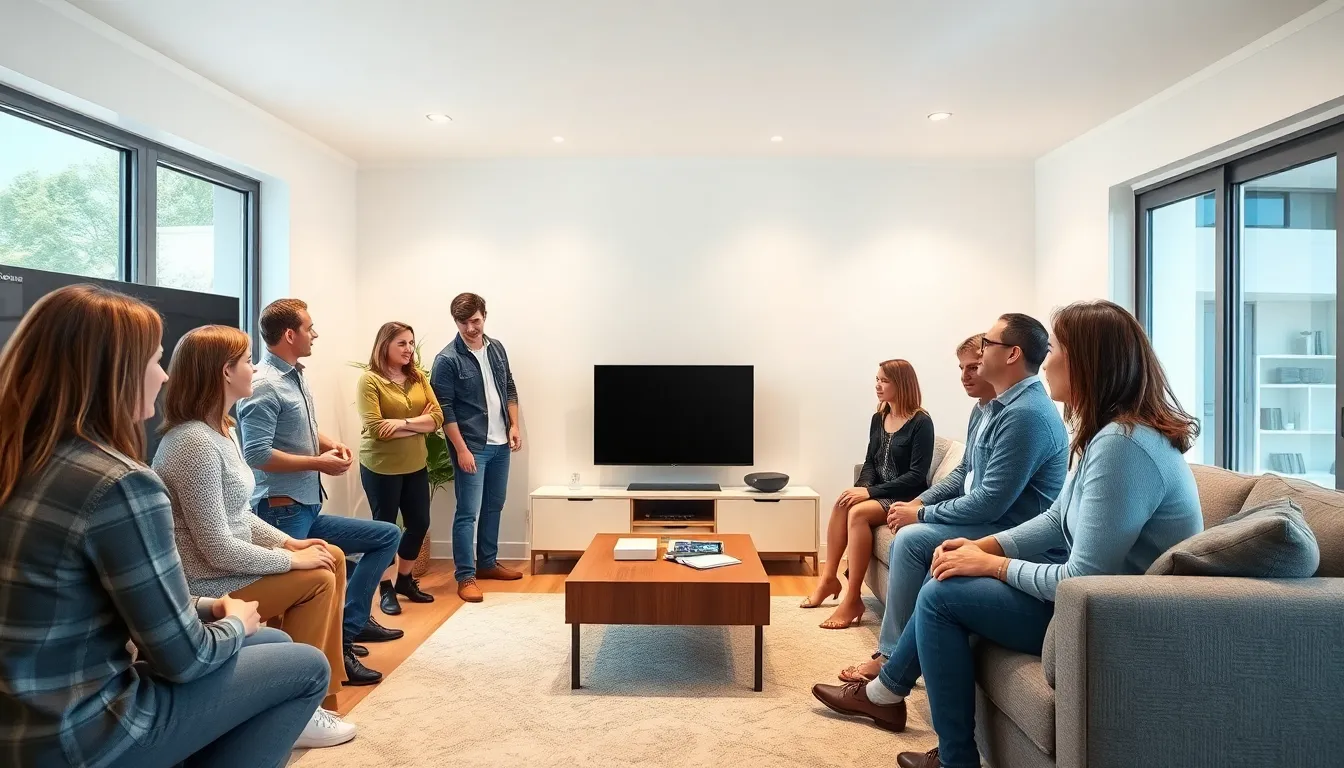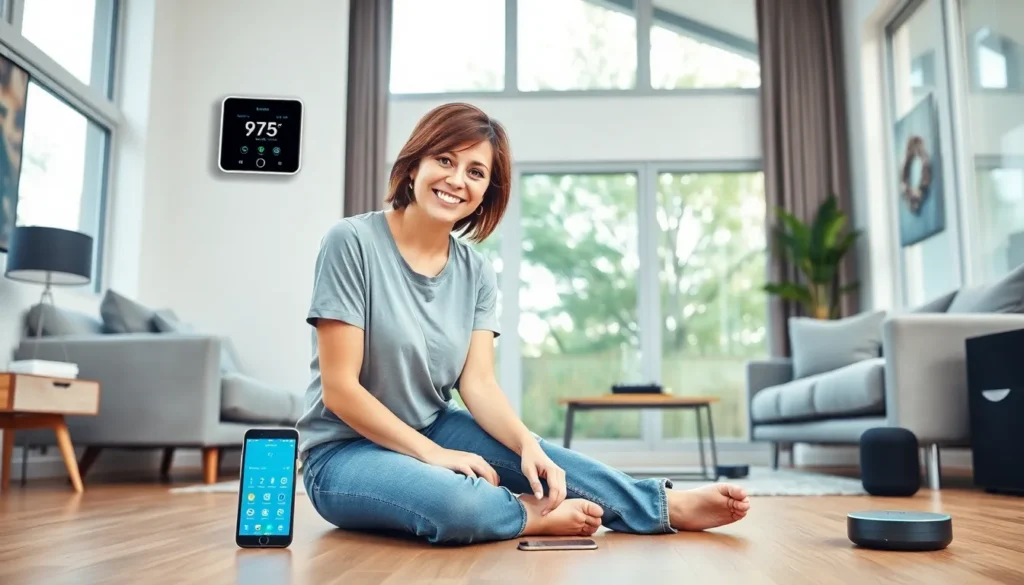Table of Contents
ToggleImagine walking into your home and having it greet you like an old friend. Lights flicker on, the thermostat adjusts to your preferred temperature, and your favorite playlist starts to play—all without lifting a finger. Welcome to the world of smart home systems, where technology meets convenience, and your home becomes your personal assistant.
Understanding Smart Home Systems
Smart home systems integrate various devices to create a cohesive, automated environment. These technologies enhance comfort, convenience, and energy efficiency in everyday life.
What Is a Smart Home System?
A smart home system consists of interconnected devices that communicate over a network. These devices include smart thermostats, lights, security cameras, and voice assistants. Each device operates seamlessly together, allowing homeowners to control their environment remotely or via automation. Smart home platforms consolidate these functions, ensuring everything works in harmony. Such systems often utilize Wi-Fi or Bluetooth technology, facilitating easy access from smartphones or tablets.
Benefits of Smart Home Systems
Smart home systems offer numerous advantages, making them popular among homeowners. Energy savings result from automation, as users can program devices to operate only when needed. Enhanced security features include real-time monitoring and alerts, which increase safety. Convenience also plays a crucial role, as controlling multiple devices from a single app simplifies daily routines. Additionally, personalized environments adjust to individual preferences, enhancing comfort at home. Smart home systems add value to properties, making them appealing to potential buyers.
Planning for Installation

Proper planning is essential for successful smart home system installation. Homeowners should consider compatibility and budget before proceeding.
Assessing Your Home’s Compatibility
Compatibility assessment involves checking existing infrastructure. Older homes may require upgrades to support modern devices. Essential technology types include Wi-Fi routers, smart hubs, and electrical wiring. Evaluation of devices you want to connect ensures seamless integration. Homeowners can consult smart device compatibility charts and manufacturer guidelines for detailed information. Additionally, a professional assessment can identify necessary adjustments, reducing future complications.
Setting Your Budget
Setting a clear budget helps streamline the installation process. Homeowners should consider initial costs of devices and installation. Pricing varies based on brand and functionality, with basic setups starting around $100 and advanced systems exceeding $5,000. Factor in potential ongoing expenses such as subscription services or maintenance fees. Prioritization of essential devices also plays a role; focus on security cameras and smart locks first, followed by smart thermostats and lighting. Effective budgeting allows for a more satisfactory smart home experience.
Installation Process
Installing a smart home system involves several steps that vary based on individual preferences and requirements. Understanding the options available for installation can lead to a more efficient setup.
DIY vs. Professional Installation
DIY installations save costs and allow for personalized configurations. Homeowners can install devices at their own pace and choose specific products. Professional installation, on the other hand, offers expertise and can handle complex configurations. They also troubleshoot any issues that may arise. Choosing between the two largely depends on technical comfort and the complexity of the desired system.
Key Components to Install
Essential components include smart thermostats, security cameras, lighting systems, and smart speakers. Smart thermostats provide temperature control and energy efficiency. Security cameras enhance safety by offering real-time monitoring. Lighting systems allow automation and mood setting. Smart speakers serve as hubs, enabling voice control over other devices. Prioritizing these components ensures a functional and efficient smart home setup.
Configuring Your Smart Home
Configuring a smart home system involves seamless integration and personalized routines. Proper setup maximizes the system’s potential and enhances overall efficiency.
Connecting Devices to Your Network
Connecting devices establishes a strong foundation for smart home functionality. Each device must link to the home’s Wi-Fi network for effective communication. Consider using a smart hub to centralize control, especially if multiple devices are involved. Smart thermostats, security cameras, and smart lights should connect to this network for efficient automation and remote access. Homeowners may encounter connectivity issues; ensuring strong signal coverage throughout the house resolves many problems. Regularly updating device software helps maintain security and performance.
Establishing Automation Routines
Establishing automation routines elevates the user experience in a smart home. Homeowners can schedule lighting to activate at sunset or program thermostats to adjust before returning home. Smart assistants facilitate voice-activated routines such as setting reminders, playing music, or managing security systems. Homeowners should prioritize essential routines for optimal performance. Examples include arming security systems when leaving or adjusting climate settings based on time of day. Testing these routines ensures reliability and makes modifications easier to implement.
Troubleshooting Common Issues
Smart home systems can present challenges during installation or operation. Identifying and resolving these common issues ensures a seamless user experience.
Connectivity Problems
Connectivity problems often arise due to weak Wi-Fi signals. Homeowners should check their router placement and ensure devices are within optimal range. Interference from walls or other electronic devices might disrupt connections. Resetting the router or moving it can enhance signal strength. A mesh network could provide expanded coverage in larger homes. If connectivity issues persist, updating firmware on devices often improves performance.
Device Compatibility Issues
Device compatibility issues can prevent smooth integration of smart home components. Before purchasing, homeowners ought to verify compatibility with existing systems and networks. Not all devices communicate effectively with each other, leading to frustrations. Researching product specifications before installation helps prevent mismatches. Testing devices post-installation ensures they function as intended. Seeking professional consultation may resolve persistent compatibility challenges or provide alternative solutions.
Embracing a smart home system can transform everyday living into a seamless experience. With careful planning and the right installation approach homeowners can enjoy enhanced convenience and security. Prioritizing essential devices and ensuring compatibility will lead to a smoother setup and operation.
Investing in smart technology not only elevates comfort but also contributes to energy efficiency and property value. By taking the time to configure and automate their systems homeowners can maximize benefits and create a personalized environment that caters to their lifestyle. With the right knowledge and resources anyone can navigate the smart home landscape with confidence.







